
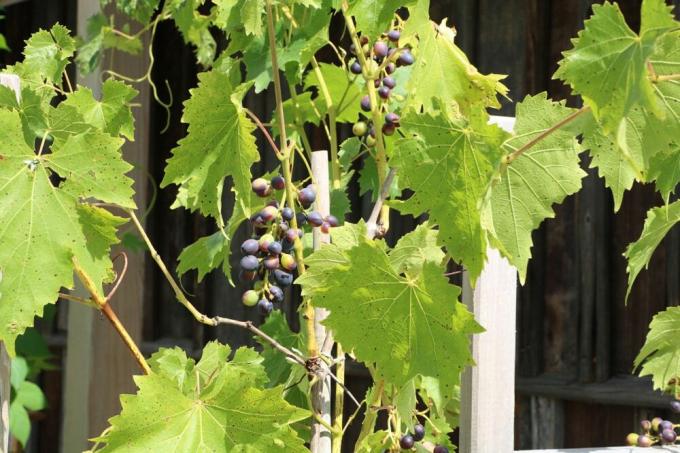
Table of contents
- basics
- shape
- incision
- In the spring
- In the autumn
- Conclusion
- useful information
Pruning is important for the health of the vine and for the subsequent grape harvest, as it needs to be trained and built up in order to provide a bountiful harvest. Grapevines are extremely tolerant of pruning and do not take offense to pruning errors, but the roots must not be severed. In addition, you should not cut too hesitantly, minor cuts are not appropriate here. If vines are not pruned, they will grow unchecked, become overgrown quickly and produce only a small number of poor quality grapes.
basics
In the German wine-growing regions, vines are grown for a bountiful grape harvest, while hobby gardeners appreciate the ornamental value of the vines. Irrespective of the motive for cultivation, they need a specific pruning so that the appearance and the yield are right. For pruning, the current temperatures must be right so that no damage occurs. If the climate in the growing region is frostier and the grape variety is extremely sensitive, pruning should be done later. In this way, frost damage from the previous winter can be better recognized and subsequently corrected. The following aspects should be considered when growing and pruning vines:
- Grapevines belong to the plant family of Vitaceae
- Vine is a high climbing shrub, tendrils reach heights of 10 meters and more
- Twigs are colored brown-yellow to red-brown
- Flowering period from June to August, with a delicate fragrance
- Weinstock puts on the flower buds in the previous year
- spherical fruits, either sweet or sour flavor
- deciduous leaves are heart-shaped to rounded
- in autumn the foliage shines with bright colors
- frost hardy and perennial plant
- Grapevines need various maintenance cuts all year round
- Adapt cutting times to the growth processes
- carry out basic pruning for shaping in the leafless period
- ideal times for pruning are late autumn to February-March
- Temperatures during pruning must not be below -5 °C
- Frost-free and dry days are ideal
- one-year-old wood is fruit wood, on which new grapes grow
- Perennial or old wood is used for the stick structure
shape
There are various ways of shaping the vines, which must be adapted to the site conditions and personal wishes. The various forms vary in difficulty in their implementation and are suitable for either beginners or advanced wine growers. The following cutting shape is well suited for hobby gardeners:
- A beginner-friendly shape for grapevines is the fan trellis
- Combination of horizontal and sloping cordon arms, which branch out several times
- Subject education fills a lot of space and has a high ornamental value
- Do not overestimate the number of legs and branches
- keep sufficient distance, approx. 0.5-1.0 meters
- Rank trellis helps with the correct shaping of the shoots
incision
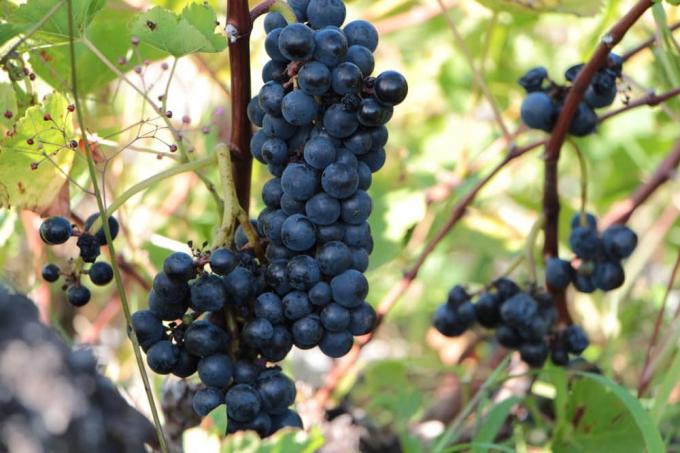
In the case of vines, pruning is usually carried out after the leaves have fallen, whereby very young vines must first be trained in the right shape and direction of growth. The following aspects should be considered when making the cut:
- in the first year of life simply let the vine grow
- Train and build up young vines at the beginning, only then prune
- with new plants, first let a strong shoot grow long and straight
- The main shoot then forms the trunk of the vine
- ideally, a kind of trunk structure can be seen in the vine
- Remove all side shoots from the future main trunk
- A clean and extremely sharp cutting tool is extremely important
- Disinfect and sharpen tools beforehand
- Cut the fruit wood as close as possible to the old wood
- leave a small stub of 1-2 cm behind the last bud
- Stump prevents the bud underneath from drying out
- Always start the cut at an angle
- Do not squeeze or injure shoots unnecessarily when cutting, otherwise they will bleed
In the spring
With a pruning in early spring, the balance between the growth of the vine and the later fruit success is promoted. This pruning is also called winter pruning and is an important process in the life cycle of a vine. With a little preparation and an initially cautious approach, the first successes can be achieved quickly with pruning:
- Prune vines in spring from February to March, this is the main annual pruning
- the harder the pruning, the greater the growth of the cane
- recognize the wood from the previous year, these are all shoots that grew in the previous year
- previous year's shoots are usually yellow-brown, ocher or red-brown
- last year's shoots have buds at a distance of 5-15 cm. When scratched, these are green on the inside
- carry out the first rough cut, shorten all thin, previous year's shoots to about 4-6 buds
- locate and mark suitable buds
- approx. 15-20 eyes per square meter should remain on the surface
- Make the second rough cut, cut off all shoots marked as unsuitable
- thicker shoots can be cut back to the main trunk
- with a radical cut, up to 90% of the branches can be removed
- last fine cut of the remaining shoots
- leave stubs with only 2-3 buds in the lower area, so-called cones
- In the upper area such shoots with 4-6 buds, so-called stretchers
Tip:
After the first rough pruning, count the buds and select only the good ones, these are noticeably thicker and are close to a thicker trunk. Marking these areas with a colored band makes it easier and more targeted to make the cut.
In the autumn
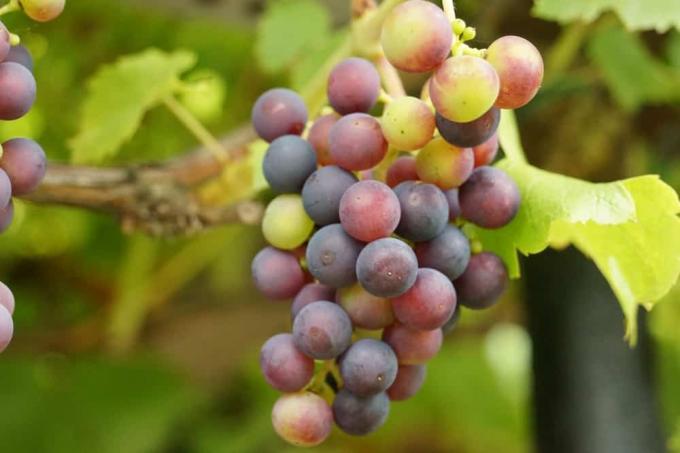
The pruning in autumn is the actual grape harvest, of course only if any fruit has formed at all. In addition to the harvest of the grapes, the vines can also be pruned at this time for aesthetic reasons especially when longer and stronger growing vine tendrils become unwanted competitive instincts next to the main trunk develop:
- cut off all ripe grapes in late autumn
- Check the degree of ripeness beforehand, some still need a few days of sun
- remove all rods which do not bear bunches
- Shorten bearing rods so that a maximum of four leaves remain on the shoot
- also cut off all overhanging and overgrown shoots
Tip:
If there is an imbalance between ripe and unripe grapes during the grape harvest period, then the area with the unripe grapes should be defoliated. In this way, the grapes get much more sun to ripen.
Conclusion
The pruning of the vines is extremely important and must be carried out annually, it is easy to handle and the pruning-tolerant plant forgives even gross beginner mistakes. If not only leaves are to grow, but also grapes, then some pruning measures are essential throughout the year. This promotes the health and growth of the vine and its grapes, woody and unsightly canes have no chance to develop. It is crucial to choose a forest-free and climatically pleasant day for pruning so that the vines can recover quickly after pruning.
useful information
One way to shape your vine is the fan trellis. This form is good for beginners. Because of the easy handling, the fan education of the vine is widespread. It is a combination of horizontal and sloping cordon arms that branch out several times. This fills a lot of space. The number of legs and branches must not be too high. There must be enough distance between them, about 0.5 to 1.0 meters.
- In the first year you just let the plant grow.
- To plant, the vine is cut back to three mature shoots at the end of the second winter.
- This way the trunk structure is loose and not too dense.
- These three shoots are loosely bent apart and attached climbing aids fastened.
- The winter cut is done on eight to ten eyes.
- Leave each arm approx. four buds for future shoots.
- One or two buds remain at each end for stem extension.
- Unneeded buds are broken off.
- The shoots for the trunk extension are brought into shape over the summer and attached to the framework.
- All shoots are allowed to keep the grapes.
- In winter, the outer shoots are cut and tied to eight to ten eyes for the stem extension.
- The shoots that are not needed for the extension are shortened to short cones with two eyes.
- Only one or two buds per shoot remain on the shoots for the stem extension. The others are broken out.
- Anyone who cannot cope with the pruning can also get professional help.
- Tree nurseries, vine dealers and maybe an experienced neighbor are usually happy to help if you get stuck.
 garden editorial
garden editorial I write about everything that interests me in my garden.
Learn more about pruning

Eucalyptus dried up: cut back now?
When a eucalyptus dries up, some owners immediately think of cutting it back. Because they want to see fresh green bud quickly. The chances of that happening may be good. But one thing must not be left out: research into the causes! Otherwise a new cycle of drying up and cutting begins.
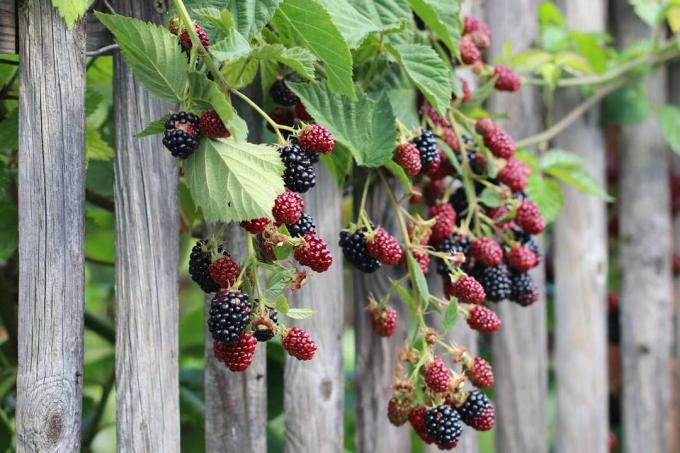
Cut blackberries: Instructions for the right cut
Bramble branches only bear fruit for one summer, after which they are used up and die off in winter. It's a good thing that new canes grow back in time for the following year. Cutting care means: What no longer supports should be removed, young rods must be optimally trained.

cutting snowball | 13 tips for pruning
When it comes to snowballs (Viburnum), the opinions of numerous hobby gardeners differ when it comes to cutting. Main reason against pruning: Destruction of the natural appearance by pruning. Find out now when it is unavoidable and which tips should be heeded.

Cutting sage: 6 tips for cutting back
Cutting measures and their ideal time depend on the species of sage plants, because they have differentiated ways of life. There are woody and herbaceous representatives that require different attention. In order to carry out the measures, a basic set of tools is helpful.

Pruning hydrangeas: when is the right time?
Hydrangeas are a real beauty because of their flowers. In the long term, however, the flowering power is only maintained if regular pruning takes place. Because cutting off withered or dried plant parts offers protection. The following guide shows when this measure should be taken.
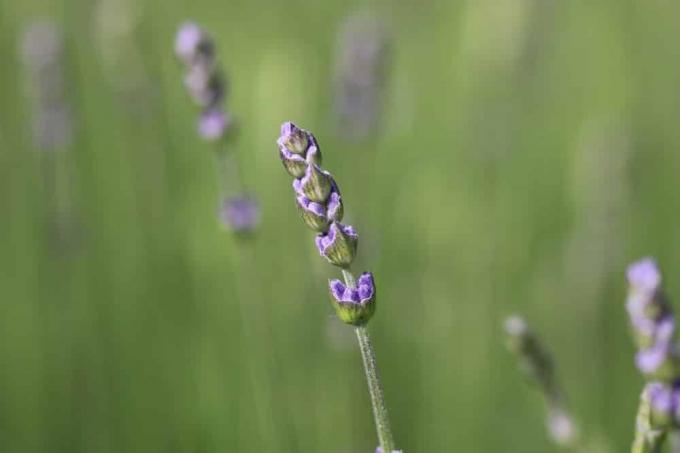
Cutting Lavender | When is the best time?
Lavender is a popular perennial, but difficult to cut. Without regular pruning, the shrub becomes lignified and less robust. Choosing the right time is important for pruning. When to cut depends on the use of the perennials.



